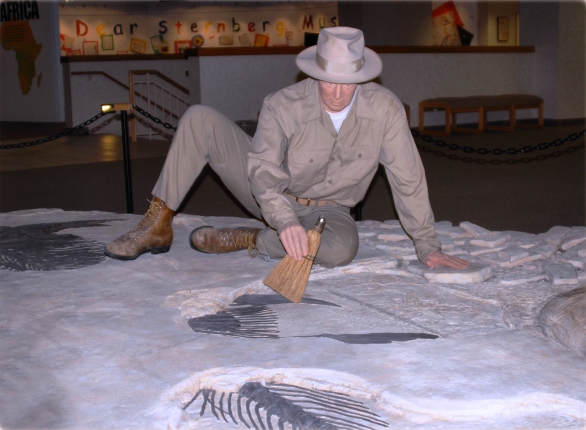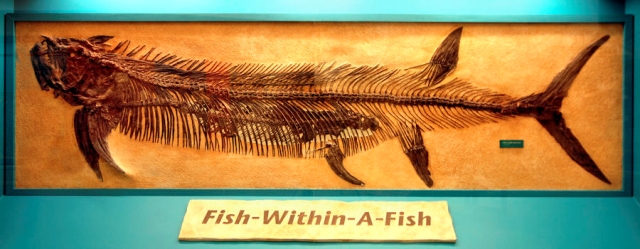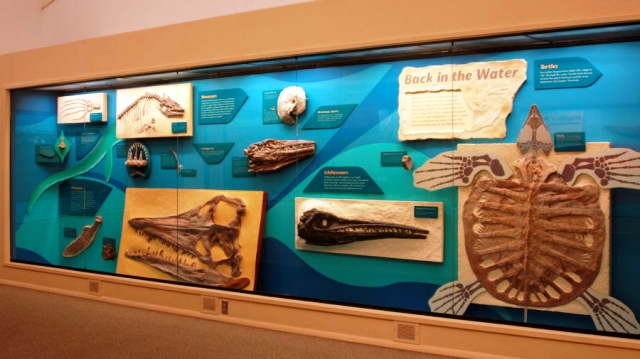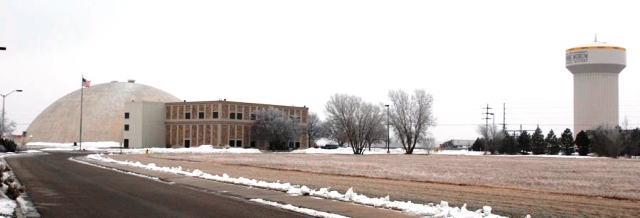An 8 Wonder of Kansas Geography
Sternberg Museum of Natural History, Hays
Address: 3000 Sternberg Drive, Hays, KS 67601
Phone: 877.332.1165
Website: sternberg.fhsu.edu
Sternberg Museum of Natural History is a finalist because...its exhibits include the fossilized remains of giant fishes and marine reptiles--some of the best, most scientifically important evidence that Kansas was under water during the last half of the Cretaceous Period (from 108 to 66 million years ago).

|
Exhibit featuring George Sternberg, discoverer of the Fish within a Fish. Photo courtesy Bruce Burkholder
|
ONE OF THE BEST NATURAL HISTORY MUSEUMS
Source: http://sternberg.fhsu.edu/about/
The museum's collections include one of the finest scientific collections of Pteranodon material, the largest collection of fossil seeds, and a truly outstanding collection of Cretaceous fossils. These are complemented by excellent collections of modern biological material, most notably mammals and plants.The Sternberg Museum of Natural History also features a realistic Cretaceous diorama, along with many exhibits. Among these fascinating exhibits is the museum's most noted specimens of an extremely well preserved Gillicus with a Xiphactinus collected by George F. Sternberg in 1952, known world wide as the "Fish-Within-A-Fish". This resulted in phenomenal growth of the museum.

|
Photo courtesy Bruce Burkholder
|
DEVELOPMENT OF THE MUSEUM
Museum collections have been used extensively in research by faculty and students at Fort Hays State University and by scholars from other institutions worldwide. First in a series of historical events that led to the presence of an outstanding museum at FHSU was the fascination of early Kansas settlers for the abundant fossils and wildlife of the region. Not long after FHSU was established as the Western Branch of the Kansas Normal School of Emporia in 1902, some private collections of these early settlers were given to the young institution.
Knickknacks and taxidermy mounts dotted different offices on campus. The first formal museum shared one half of a large room with the library in Picken Hall. In 1914, C.F. Miller was appointed as the first curator. By 1915 the library was in need of more space, and the museum specimens were pushed aside.

|
Photo courtesy Bruce Burkholder
|
Museum and university administrators sought a way to preserve and use these specimens for public display and educational purposes. This led to the appointment of George F. Sternberg to develop the museum as it moved to quarters in the new McCartney Hall. Sternberg, a famous fossil collector and preparator, collected his first notable fossil, a complete plesiosaur in 1892, at the age of 9. He, along with others at the university (including the famous mycologist Elam Bartholomew), amassed materials for exhibits, research, and education.
George spent the remainder of his life developing the public and education portion of the museum as well as the paleontology and geology research collections. Intended primarily as an academic support facility, the museum soon became a notable attraction. Local and regional citizens brought guests, and schoolteachers throughout western Kansas scheduled field trips to visit the growing museum.
After George's death in 1969, the Sternberg Geology Club petitioned the university for the public portion of the museum to be named in honor of the Sternberg family. In the 1970s, the administration of Sternberg Memorial Museum began to emphasize tourism and education as a part of the mission of the museum. An expanded mission stressed the use of collections as educational resources for persons of all ages, including school children, university students and faculty, local citizens, and tourists.
Continued growth of the museum led to a lack of collection space, overcrowded displays, reduced research space, and limited public access. Furthermore, as a result of the FHSU campus being situated on a flood plain, museum specimens were water damaged on several occasions. With collections stored in multiple buildings, proper conservation and environmental control was difficult. By the mid 1980s university administration recognized the potential benefits of SternbergMuseum moving to a location offering more public exhibits, research and collection space, easier access, and great visibility.

|
Photo courtesy Bruce Burkholder
|
A domed building built in the 1980s as a private athletic club offered the museum just that. With the acquisition of it in 1991, the academic collections known as the Museum of the High Plains were merged with the Sternberg Memorial Museum to become the Sternberg Museum of Natural History. Ambitious plans to develop a world-class museum and tourist attraction continue to demonstrate the museum's commitment to science, education, and tourism.
MUSEUM EXHIBITS
Click here to learn about museum exhibits.
HOURS:
Winter: Tuesday-Saturday 9 a.m.-6 p.m.; Sunday 1-6 p.m.
Memorial Day through Labor Day: Monday-Saturday 9 a.m.-6 pm.; Sunday 1-6 p.m.



